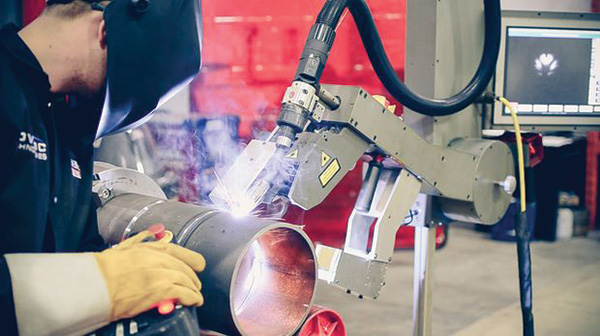August 2019, Vol. 246, No. 8
Tech Notes
Bringing High-Tech Welding for Oil and Gas Pipes
Many oil and gas projects – ranging from onshore refineries to LNG terminals to offshore platforms – require extensive piping to connect process oil and gas.

These projects are often on a fast track schedule and have limited on-site space, which makes them have to rely heavily on offsite fabrication and assembly. As a result, a timely supply of pipes and spools to the installation site can often make or break a project.
Offsite fabrication or pre-fabrication is the process of taking raw pipes and fittings, such as flanges, elbows and tees, and welding them together to form a pre-fabricated spool that can fit into other spool components.
Roll-fitting and welding is a key part of this process and means the main pipe can be turned by a positioner or rolling machine where the welder does not need to change the torch position around the pipe to perform the operation.
There are many advantages to pre-fabricating spools, including:
- Overall time and cost-savings vs. field installation
- Improving quality in a controlled shop environment vs. on-site installation
- Minimizing the effect of weather delays
- Effectively using labor in a manufacturing-type environment
- Better control of welding parameters
The manufacturing industry has seen massive changes over the past few years, with many of those changes driven by industrial automation.
The good news is industrial automation is also helping to solve a number of difficult issues in manufacturing. One of those issues is the skilled labor shortage faced by the oil and gas industry.
The labor issue is positioned to only get worse, as many welders are nearing retirement and fewer millennials are being trained to fill the gap and take over these skilled positions.
Fabrication shops are struggling to find skilled welders while facing the reality of an aging workforce and finding cost-effective and innovative ways to increase welder productivity. The good news is that global challenges are driving innovation.
Novarc Technologies invented the Spool Welding Robot (SWR) – to change the status quo. Novarc’s SWR is not designed to replace workers, but rather to have a junior, less-experienced, operator work collaboratively with the robot to supervise as it tackles and perfects the challenging pipe welding process.
Novarc’s SWR is used by fabrication shops servicing various manufacturing sectors including the oil and gas industry.
Currently, a leading fabricator for the oil and gas industry is using the Novarc SWR, primarily for stainless steel pipe welding. After training pipe-fitters on how to operate the robot, they’ve achieved X-ray quality welds, and successful ultrasound tests on more than 700 pipe welds.
Before purchasing the robot, the facility’s main bottleneck in the fabrication process was pipe welding. After implementing Novarc’s solution into the operations, the process improved significantly, and the bottleneck has shifted from welding to the pipe fit-up and prepping.
And like other SWR users, the fabrication shop has been able to cut the average welding time in half, increasing production capacity and driving down costs.
Beyond helping to provide a solution to the labor shortage, welding automation system can deliver a 400% increase in productivity vs. shielded arc welding (SMAW) and 75% lower cost-per-joint vs. SMAW.
The SWR provides supervisors with production monitoring, daily operations and log reports for future analysis, resulting in scalable, repeatable and reliable welding quality.
Novarc’s NovEye was recently introduced and integrates artificial intelligence with machine vision, offering pipe fabrication shops the benefits of higher levels of autonomy with the SWR and even less risk of defects in each weld.
The AI-powered welding vision system has a camera built into the robotic arm, which processes each weld image and data and reduces the number of inputs required from operators, meaning operators can perform more welds in less time. P&GJ





Comments